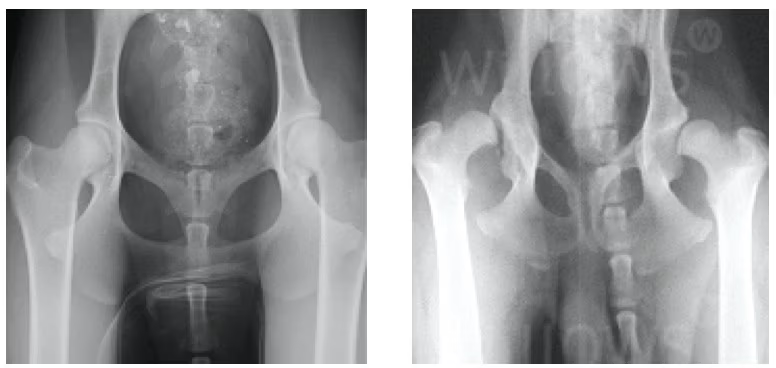Remember the moment you first decided to get a puppy? Your days and weeks were filled with planning everything for the new arrival. You wrote a list of all the supplies for the new addition: toys, bowls, leashes, dog food, etc. One thing didn’t make the list – medication. It never even crossed your mind, and why would it? When you’re getting a puppy, you expect everything to be just fine – they are supposed to be a blank slate, after all. Even more so if they come from a reputable breeder.
Unfortunately, reality sometimes differs from our expectations, and some owners find themselves facing a hard diagnosis of hip dysplasia in their puppies only a few months after getting them. This diagnosis comes with many tough decisions and even more tough questions. Will your dog have to be on strong medication for the rest of his life? Will he need surgery? Is recovery even possible, or does this diagnosis mean a lifetime of pain and suffering? In no way is hip dysplasia an easy diagnosis to face or an easy condition to manage, but there is hope. It may be a lifelong condition, but it’s not a death sentence.
CBD oil is a champion supplement in the world of holistic veterinary medicine. If you google all of its benefits, you can’t help but wonder, is there anything it can’t do? It has been known to work better than some traditional medication, especially when it comes to pain management. Many dog owners report success stories and testify that CBD has become a crucial remedy for their dog’s ailments, dysplasia-related joint pain included. But some remain skeptical. In this article, we’ll first look at the details of this scary condition and then uncover the potential of CBD oil for dogs with hip dysplasia!
Definition of canine hip dysplasia
It’s impossible to understand this condition without first looking at how the hip joint is formed. The joint in the hip consists of a ball (that is attached to the thigh) and a socket (that is part of the pelvis). In order to have a healthy hip, both of these parts should grow evenly and fit together like two puzzle pieces. For dogs with hip dysplasia, this doesn’t happen. The joints don’t form properly, eventually becoming loose and unstable. This deformity in the growth is called hip dysplasia. You can see two x-rays below, one of the healthy canine hips (left) and one of the dysplasia hips (right). Notice how the joints on the left fit together perfectly and how loose are the joints on the right.

Causes, prevention and most commonly affected breeds
Hip dysplasia is a genetic condition, passed onto the puppy through a combination of genes inherited from his canine parents. Environmental factors can play a big role in triggering hip dysplasia in dogs that already have a genetic predisposition to it. The two main factors are diet and exercise. Studies have shown that puppies who are overfed in their first few months are at high risk for developing hip dysplasia. When puppies gain too much weight too fast, their joints grow improperly, due to the increased pressure.
Similarly, young dogs should not be over-exercised and should avoid stairs, if at all possible, until their bones are fully grown. The lack of exercise can be just as harmful because movement is vital for healthy development! Puppies should engage in outdoor activities, so long as they’re done on gentle terrain and in moderate time frames. These prevention measures are something every dog owner must take into consideration, but owners of larger breeds even more so. Hip dysplasia is most commonly found in large breeds such as Labrador Retrievers, Golden Retrievers, German Shepherds, Great Danes, Saint Bernards and Newfoundlands. Please note that this does not mean smaller breeds cannot be affected by this condition – they can!
Symptoms of hip dysplasia in dogs
Hip dysplasia develops in young dogs, during the first few months, but they may not start showing any symptoms of hip pain and deformity until later in life. Dog owners become aware that something is off with the dog’s hips when they notice lameness, meaning the dog’s stance and walk are visibly impaired and abnormal. The common signs are:
– Dragging the hind legs
– Limping
– A wobbly walk, hips swaying left and right
– Difficulty standing up and lying down
– Difficulty going up and down the stairs
– Refusing to exercise and play
Think back to how the hip joint is formed, the ball and the socket. The dysplasia-affected joint didn’t develop properly and is very loose, so its two parts aren’t moving smoothly. Instead, they are clashing against one another, affecting the dog’s physical stability and causing him a lot of pain. The signs of dog hip pain appear as licking the legs and joints, moaning, and changes in his mood, appetite, and sleep patterns. All of these signs can appear while your dog is still a puppy, or when he is a couple of years old.
The difference between hip dysplasia and arthritis
Many dogs with hip dysplasia also have arthritis, but not all dogs with arthritis have hip dysplasia – so what is the difference? Hip dysplasia is a genetic condition, whereas arthritis develops later in life as a result of joint inflammation. Inflammation can be caused by injury or improper growth. Since hip dysplasia is a condition of improperly formed hip joints, it eventually leads to arthritis. The joints move improperly and get continuously inflamed as a result, causing painful arthritis over time. This is why a dog can get both diagnoses at the same time, especially if he is already a couple of years old before the first signs of pain and lameness appear.
Traditional treatment options
After the diagnosis is confirmed with an x-ray, there are several ways to manage this condition, depending on how severe it is and what role environmental factors played in its occurrence. The veterinarian may suggest adjusting the level of exercise and putting the dog on an appropriate diet if he’s overweight. Special supplements may also be prescribed, such as glucosamine and omega-3. Physiotherapy can be helpful as well, particularly hydrotherapy.
Along with these options of managing hip dysplasia, most dogs are instantly prescribed strong nonsteroidal anti-inflammatory drugs (NSAIDs), to manage their pain and inflammation. In some cases, the vet will suggest surgery. There are two main types of surgery for canine hip dysplasia. The first one is reconstructive surgery, which maintains the dog’s own joints as their position is surgically corrected. The second option is the salvage surgery, which can either mean a total hip replacement or removing only the ball part of the loose joint. Pain medication is prescribed after surgery.
The downside of traditional treatment
While different veterinarians may choose different treatments based on the dog’s age and severity of his hip dysplasia, the one thread that connects them all are the NSAIDs. These drugs come with high risk, especially if they are prescribed for long-term use. Seeing as canine hip dysplasia is a life-long condition, this is usually the case. NSAIDs are known to have strong and harrowing side effects. The most commonly reported side effects are vomiting, diarrhea, decreased energy level, and loss of appetite. If you compare these side effects with the symptoms of pain, you’ll find that they are eerily similar. Medication that is supposed to help dogs with pain and improve their quality of life is essentially giving them all the same symptoms.
There are absolutely cases where strong pain medication has its rightful place and can serve a useful purpose for a short time, but it is no secret that these drugs are dangerous and should be avoided if at all possible. The FDA (US Food and Drug Administration) refers to them as “a balancing act.” The most severe and truly worrisome side effects of NSAIDs include stomach and intestine damage, liver failure, kidney failure, and in some heartbreaking cases, even death.
Once we learn these facts, it becomes evident that nonsteroidal anti-inflammatory drugs aren’t the safest option and come at enormous risk, putting dog owners in a tough position when facing a life-long diagnosis such as hip dysplasia. How can they possibly manage their dog’s hip pain in the following years, sometimes a decade? Is there a natural and (most importantly) safe alternative to traditional medication?
CBD Oil as Pain Relief for Dog Hip Dysplasia
CBD has been known to have a myriad of positive effects, especially when it comes to pain and inflammation. The way CBD works is by stimulating the endocannabinoid system (ECS) that is present in all mammals and regulates many important functions in the body – inflammation, and pain being two of them. These are the two problematic areas (and so the target areas for treatment) for dogs who are experiencing hip problems. As CBD oil stimulates the ECS receptors, it naturally decreases inflammation symptoms, without any psychoactive effects! This makes it a valuable treatment option for dogs with hip pain.
Science advocates for CBD oil
Several studies have been done that highlight CBD’s ability to manage pain and inflammation. Most of these studies have been conducted on animals, but one human study found that most people who take CBD use it to manage pain – chronic pain and joint pain being the leading two reasons. Even more exciting – in 2015, an animal study showed that topical application of CBD (meaning, applying it directly to the affected area) has the potential to treat the symptoms of arthritis. Since dogs with hip dysplasia eventually develop arthritis, this positive research is of immense importance to dog owners who may still be on the fence about CBD oil. With each new research that emerges, the benefits are impossible to ignore.
Choosing the right CBD product for your dog’s hip pain
Choosing the right product is very important when it comes to CBD. While most dog owners opt for products that can be ingested (oils, tinctures, treats), those are not the only options. The 2015 study mentioned above states that metabolism can play a role in the effectiveness of CBD, so in some cases, the topical application to painful and inflamed joints could be the best choice. You should feel comfortable discussing these options with your holistic veterinarian and the manufacturer from which you intend to purchase the CBD product. They are both highly likely to know of specific cases similar to yours and can provide information on which product would best support your dog.
While CBD oil is a great option for dogs with hip problems, remember that each dog is unique, and the product (and dose) that is perfect for one might not work for the other. Having a dog who is struggling with hip pain is a big stress for both the dog and the owner, but people are too quick to give up and become desperate for a quick fix. Be patient as you navigate this difficult season in your life and allow your dog’s body to show you how it responds to the natural treatment. Remember that you have options and can always try a different CBD product if the first one isn’t showing desired results.
CBD oil and dog hip pain success stories
Reading through the medical and scientific information is one thing, but getting to know real-life stories is another. These are the first-hand testimonials that will encourage you to stay patient and motivated on this journey. Memphis, a 12-year-old Pit Bull with several problems in his old age (one of them being hip pain), began receiving CBD oil and went from a high dose of pain medication to being completely pain-medication free!
Rosie was diagnosed with hip dysplasia and cancer. After being put on CBD, her condition showed improvement in a matter of days! Her pain has decreased and she became more active, her owner stating she was “a different dog” who also regained her appetite and didn’t have any side effects to CBD.
A truly remarkable story is also one of Annie, a 9-year-old German Shepherd, who had big difficulties with walking, due to hip dysplasia and arthritis. Because she was diagnosed later in life, the owner didn’t want to put her through the heavy surgery and opted for an alternative way of managing her dog’s condition instead – CBD oil. It was definitely the right choice, as Annie isn’t in pain anymore – she can walk again, isn’t dragging her legs and is doing much better overall!
Final Thoughts
Canine hip dysplasia is a life-long condition that causes a lot of pain and affects the dog’s ability to move and exercise comfortably. It’s a genetic disease, so there is often no way of knowing which puppy will become affected by it, although there are several environmental factors that can trigger it (mainly improper diet and exercise). The biggest part of treating this condition is managing pain and inflammation. Usually, strong pain medication is prescribed, making dog owners worried worrisome. They don’t want their beloved companion to spend the rest of his life on medication – especially one that has harmful side effects.
CBD oil once again proves itself as a light of hope for dogs with hip problems, with its incredible anti-inflammatory and pain-relief benefits. The use of CBD has not been recorded to pose a risk to the dog’s health, unlike the use of pain medication. Dogs who have been struggling with hip pain and couldn’t exercise, have shown visible signs of improvement in a matter of weeks after taking CBD. It’s safe to conclude that CBD oil immensely improves the quality of life for dogs with hip dysplasia and allows them to live a more active, pain-free life.
Sources
Hunter, Tammy. “Hip Dysplasia in Dogs.” VCA, 2019.
“Hip Dysplasia.” Willows Veterinary Centre & Referral Service.
“How Long Can a Dog Live With Hip Dysplasia? Complete Guide.” Medrego, 08/04/2019.
“Get the Facts About Pain Relievers for Pets.” FDA, 26/09/2019.
Dr. Regehr. “Hip Dysplasia and Arthritis Are Not the Same Thing.” Perimeter Veterinary Center, 19/05/2014.
Bensimoun, Claudia. “Environmental Factors Can Affect the Incidence of Hip Dysplasia.” USDAA Dog Agility, 11/02/2019.
Hammell, D.C. Zhang, L.P. Ma, F. Abshire, S.M. McIlwrath, S.L. Stinchcomb, A.L. Westlund K.N. “Transdermal Cannabidiol Reduces Inflammation and Pain-Related Behaviours in a Rat Model of Arthritis.” PMC, 30/10/2015.
Corroon, Jamie. Phillips, Joy A. “A Cross-Sectional Study of Cannabidiol Users.” PMC, 01/07/2018.
Natalie. “I Do Not Have to Give Him Pain Medication…” Holista Pet.
Armstrong, Blake. “Warning: If You Use CBD to Treat Hip Dysplasia Your Dog Will Love You Even More Than He Does Right Now.” Cannabis for Pets.
Li, Johanna. “How CBD Oil Helped This Elderly German Shepherd Walk Again.” Inside Edition, 30/10/2018.

Luna’s passion for learning about canine psychology and behavior began when she adopted a severely reactive puppy from a local shelter. She is now a big advocate for positive reinforcement and compassionate training. As a writer, she strives to spotlight the topics that fly under the radar and be the voice for all who cannot speak for themselves.




Leave a Comment